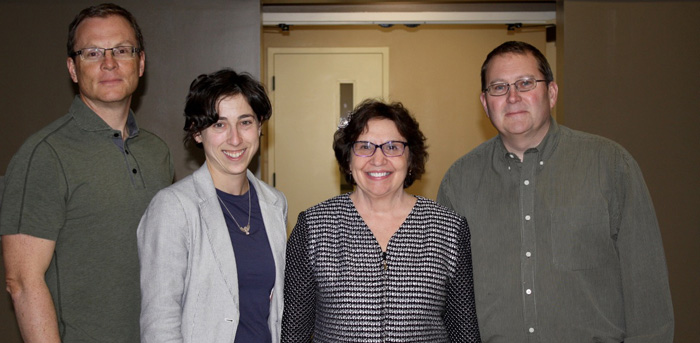Chamallas Lectures on Tort Law’s Continued Resistance to Gender-Inclusivity
 On March 28, 2016, Martha Chamallas, holder of the Robert J Lynn Chair in Law at the Moritz College of Law at Ohio State University, delivered the second Tort Law Research Group public lecture of the 2015-16 academic year. Addressing an audience of students, faculty, and lawyers, Professor Chamallas spoke on the topic of gender-inclusivity in tort law. Professor Chamallas argued that while tort law is now formally gender neutral—it has done away with gender-specific causes of action and has sanitized itself of gender-specific terminology—in several significant spheres, it remains resistant to substantive gender-inclusivity.
On March 28, 2016, Martha Chamallas, holder of the Robert J Lynn Chair in Law at the Moritz College of Law at Ohio State University, delivered the second Tort Law Research Group public lecture of the 2015-16 academic year. Addressing an audience of students, faculty, and lawyers, Professor Chamallas spoke on the topic of gender-inclusivity in tort law. Professor Chamallas argued that while tort law is now formally gender neutral—it has done away with gender-specific causes of action and has sanitized itself of gender-specific terminology—in several significant spheres, it remains resistant to substantive gender-inclusivity.
In three contexts, (i) domestic violence, (ii) rape and sexual abuse, and (iii) reproductive injuries, tort law reveals its deep-seated gender bias. Adopting the role of the “tort doctor,” Professor Chamallas set out to diagnose the root causes of tort law’s continued lack of gender-inclusivity in these three areas and offer potential cures.
In the context of domestic violence, Professor Chamallas identified the root cause as “boundary anxiety.” In cases of domestic violence, there is an inclination to steer these cases away from tort and into either criminal or family law. Domestic violence is the leading cause of death for women between the ages of 15 and 44 as well as for pregnant women, and yet tort claims for domestic violence are “exceedingly rare.” The unavailability of insurance for domestic violence is a likely explanation for this dearth, in an age when “torts follow the insurance.” Another insidious explanation lies in the widespread notion of how female victims of domestic violence should behave. Female tort plaintiffs, scholars have argued, represent a challenge to the idea of a deferential criminal victim who looks to male police officers, prosecutors, and judges for assistance. Professor Chamallas argued that this boundary anxiety could be assuaged by simply recognizing that we can address wrongs in multiple arenas. In other words, there is room for civil actions alongside criminal and family law claims.
In the context of rape and sexual assault, Professor Chamallas argued that “sexual exceptionalism” was to blame. Most tort claims of sexual assault involve a claim in vicarious liability against third-party institutional actors, such as employers, universities, or hospitals. Professor Chamallas noted that courts are less likely to impose vicarious liability for the commission of a sexual assault than they are for a non-sexual assault. Courts seem to think that sexual misconduct is deemed exceptional, occurring because of “propinquity and lust,” not because of environmental factors. A solution to sexual exceptionalism lies in effective feminist critiques of workplace harassment, aimed at changing cultural assumptions, so that we no longer think of sexual harassment at work as due to the dispositional traits of the individual actor, but to the overall employment environment.
Finally, in the context of reproductive injury, Professor Chamallas diagnosed the cause as “binary fixation.” A woman who suffers a miscarriage because of a doctor’s negligence must fit her claim under the tort of negligent infliction of emotional harm, a claim that is subject to more stringent rules than an equivalent claim for negligently inflicted physical harm. By limiting her claim in this way, tort law also fails to recognize that a death of a fetus has physical, emotional, and relational components. Professor Chamallas urged the recognition of a new reproductive tort; one that protects the reproductive choice of parents and denies a binary fixation according to which the harms tort protects us from must be either physical or emotional.
Professor Chamallas’ remarks serve as a warning to those who think that tort law’s formal steps to eradicate gender bias have been sufficient. Drawing on Reva Siegal’s insight of “preservation through transformation,” Professor Chamallas cautioned that although we have done away with most of the rules and rhetoric that entrench gender bias, the hierarchy that devalues harm suffered by women remains much the same, especially in the three gender-salient contexts she outlined.
Professor Chamallas is a leading scholar in a number of fields, including torts, employment discrimination law, and legal issues affecting women. She is the author of two books (The Measure of Injury: Race, Gender, and Tort Law, co-authored with Jennifer Wriggins; and Introduction to Feminist Theory, now in its third edition) as well as more than 40 articles and essays. She is a member of the American Law Institute and has participated on Gender and Risk Bias Task Forces for the states of Iowa and Pennsylvania.
The Tort Law Research Group’s public lecture series is generously sponsored by Legate and Associates LLP. Legate and Associates prides itself on its client-centred team approach that takes personal injury personally and fiercely advocates on behalf of its clients. Founding lawyer Barbara Legate, a graduate of Western Law, has argued significant cases in a wide variety of situations, from administrative tribunals to the Ontario Court of Appeal. She was recently named 2014 Lawyer of the Year in Personal Injury Litigation.






